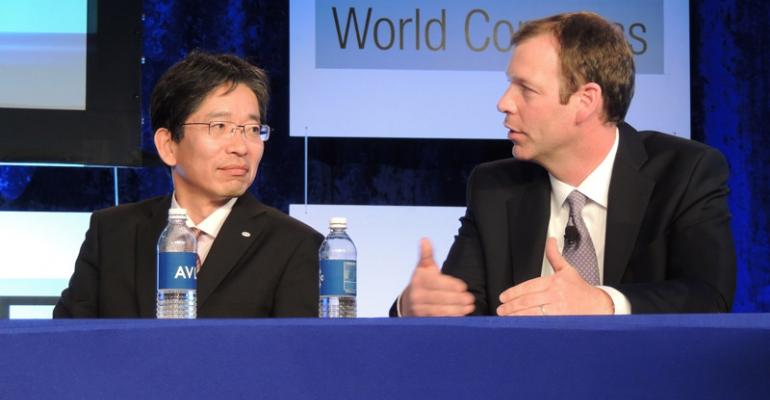DETROIT – Auto industry leaders believe autonomous vehicles could be seen on the world’s roadways by 2025, perhaps even sooner, although a complex web of regulatory and legal issues stands to block what they consider a last avenue to improve vehicle safety.
“Progress has stalled” on improving vehicle safety, says Jeff Owens, chief technology officer and senior vice president, Delphi, at the 2013 SAE World Congress here.
According to the National Highway Traffic Safety Admin., crash fatalities in the U.S. hit a 60-year low in 2011. Experts at the annual SAE event say advances in vehicle safety, such as electronic stability control, combined with years of awareness programs concerning impaired driving and seatbelt use, led to the trough.
However, deaths from motor-vehicle crashes spiked last year, NHTSA data shows, up more than 7.0% for the highest fatality rate since 1975. Americans drove more miles in 2012, which NHTSA says may have skewed the results slightly, but industry safety engineers also blame a sharp rise in distracted driving.
The U.S. Department of Transportation estimates distracted driving is to blame for more than 3,300 deaths on U.S roadways last year. Another 387,000 motorists were injured as a result of the phenomenon, USDOT statistics show.
Jay Joseph, senior manager-U.S. product regulatory office at Honda, says his daily commute along Interstate 405 in Southern California bears proof distracted driving has reached epidemic proportions.
“I see one new bad habit, or ridiculous habit, by someone behind the wheel every day,” Joseph says in an address to an SAE panel focusing on distracted driving and autonomous driving.
The distracted-driving phenomenon has prompted regulators to draft a set of proposed guidelines for the industry to follow for items such as infotainment.
It is expected the guidelines, which are due later this year in concrete form and are drawn upon a framework the industry composed for itself several years ago, will urge auto makers to develop safer ways for drivers to use their smartphones inside the vehicle.
But Joseph bucks the prevailing thought by suggesting the solution to distracted driving may not be a technical one.
“Instead of seeing distraction due to electronic devices as the cause of so many crashes, maybe we could see that poor decision-making was a factor in most fatal crashes,” he offers. “It may help us find the root cause if we look at the problem differently.”
Targeting smartphones may not be the wisest use of resources in the battle against distracted driving, Joseph says.
“The concern I’m raising is that we continue to chase after individual sources of distraction, but they will prove to be mercurial. And if we attempt to address potential distractions, they simply will be replaced by different distractions.”
More regulation, such as the NHTSA guidelines, might not be the answer, either, he adds. They would take time to adopt correctly and could be at odds with consumer demands.
“It seems likely we will have a learning process along the way and probably some growing pains,” he says. “If the pending guidelines are taken too literally, we could be facing a virtual prohibition of the use of many in-vehicle electronic and handheld devices.”
Alcohol prohibition in the U.S. led to bootlegging, Joseph points out. The auto industry already is witnessing its equivalent, as rogue developers make plug-in handheld devices to beat the lockouts auto makers build into items such as navigation systems.
“The point is, restrictions have their consequences, and we don’t want to drive people to behavior that is worse than what we are trying to address,” he says. “It gets back to the notion of addressing the root cause of distraction instead of the symptoms.
Kazuoki Matsugatani, director-corporate research and development, Division 3, at Denso, says the parts giant is researching ways the vehicle can lighten a driver’s workload by automating more secondary tasks.
But the challenge is determining how much workload a vehicle should assume and overcoming distrust drivers may have for such technologies.
Robert Yakushi, director-product safety, environmental at Nissan, adds legal issues, driver training and the need for broader collaboration between key stakeholders in clearing the technical and regulatory hurdles in the battle to reduce distraction.
“Perhaps the most difficult challenges lie ahead in the fields of policy, standards and customer acceptance,” he says.
Automated driving will come, nonetheless, says Christian Schumacher, director-advanced driver assistance systems, NAFTA region, at Continental. He predicts highly automated driving by 2020 and full automation by 2025. “Most likely, even earlier than this, but in a limited amount.”
Schumacher agrees more work remains, such as speeding up the information sharing between vehicles and infrastructure to real time. After that, real-world validation of the technology and certification of the vehicles equipped with it will take time.
“All of this has to be checked, and it is from my perspective the major reason why automated driving will take time to get into production,” he says.
The University of Michigan Transportation Research Institute in 2012 launched a 1-year, $25 million road test of connected-vehicle safety technology involving 3,000 vehicles under real-world driving conditions. It is the world’s largest such research project examining driver behavior and vehicle-to-infrastructure communication of its kind.
Paul Sweatman, director-UMTRI, says implementation of the program has been “tremendously successful.” Feedback will help NHTSA determine which technology it may regulate that auto makers add to future vehicles.
However, Sweatman says for autonomous driving technology to work it must be credible and reliable. A rear-parking-assist system, for example, gives drivers immediate results. But they might question another technology such as a speed warning as they approach a curve in the roadway.
“Who says I’m going too fast into the curve?” he asks rhetorically, “so we need things with a lot of credibility.”
At this point, says Sweatman, humans remain better at detecting and avoiding crash situations than machines. “Technology standards and regulation for risk detection are a critical long-term need.”





